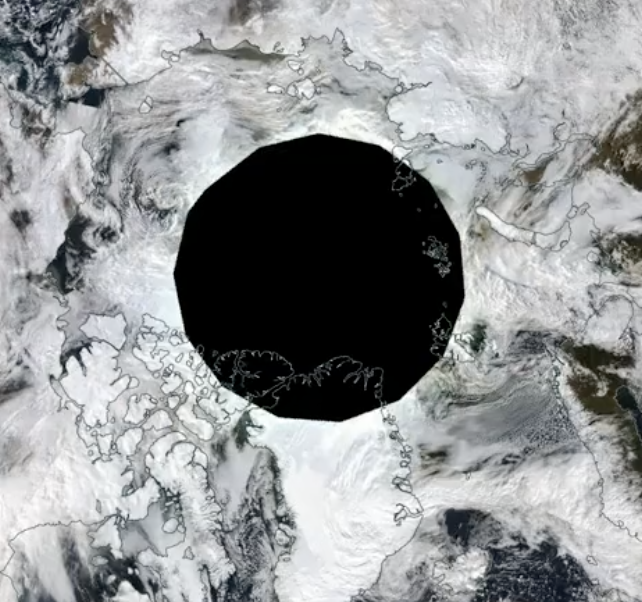Winter is coming and with it some very long nights for residents in the North Pole.
The darkness is starting to spread from the North Pole and southwards. Eventually, far northern portions of Alaska/Russia will not see the sun rise for nearly 6 months with up to 60-67 true days of total darkness. pic.twitter.com/ZDmIgHAsPO
— Shea Gibson (@WeatherFlowCHAS) October 13, 2022
The polar night is a phenomenon where the nighttime lasts for more than 24 hours that occurs in the northernmost and southernmost regions of Earth. This occurs only inside the polar circles. The opposite phenomenon, the polar day, or midnight sun, occurs when the Sun remains above the horizon for more than 24 hours.
“Night” is understood as the center of the Sun being below a free horizon. Since the atmosphere refracts sunlight, the polar day is longer than the polar night, and the area that is affected by polar night is somewhat smaller than the area of midnight sun. The polar circle is located at a latitude between these two areas, at approximately 66.5°. While it is day in the Arctic Circle, it is night in the Antarctic Circle, and vice versa.
Types of polar night
As there are various kinds of twilight, there also exist various kinds of polar night. Each kind of polar night is defined as when it is darker than the corresponding kind of twilight. The descriptions below are based on relatively clear skies, so the sky will be darker in the presence of dense clouds.
Polar twilight
Polar twilight occurs in areas that are located at the inner border of the polar circles, where the Sun will be on or below the horizon all day on the winter solstice. There is then no true daylight at the solar culmination, only civil twilight. This means that the Sun is below the horizon, but by less than 6°. During civil twilight, there may still be enough light for most normal outdoor activities because of light scattering by the upper atmosphere and refraction. Street lamps may remain on and a person looking at a window from within a brightly lit room may see their reflection even at noon, as the level of outdoor illuminance will be below that of many illuminated indoor spaces. It occurs at latitudes between 67°24’ and 72°34’ North or South, when the Sun does not rise, only civil twilight visible.
Northern Hemisphere:
- 68° North: December 9 to January 2
- 69° North: December 1 to January 10
- 70° North: November 26 to January 16
- 71° North: November 21 to January 21
- 72° North: November 16 to January 25
Southern Hemisphere:
- 68° South: June 7 to July 3
- 69° South: May 30 to July 11
- 70° South: May 24 to July 18
- 71° South: May 19 to July 23
- 72° South: May 14 to July 27
Civil polar night
The civil polar night period produces only a faint glow of light visible at midday. It happens when there is no civil twilight and only nautical twilight occurs at the solar culmination. Civil twilight happens when the Sun is between 0 and 6° below the horizon, and civil night when it is lower than that. Therefore, the civil polar night is limited to latitudes above 72° 34′, which is exactly 6° inside the polar circle. Nowhere on mainland Europe is this definition met. On the Norwegian territory of Svalbard, however, civil polar night lasts from about 11 November until 30 January. Dikson, in Russia, experiences civil polar night from December 6 to January 6. During dense cloud cover places like the coast of Finnmark (about 70°) in Norway will get a darker “day”. On the Canadian territory of Pond Inlet, Nunavut, however, civil polar night lasts from about 16 December until 26 December.
Nautical polar night
During the nautical polar night period, there is no trace of daylight, except around midday. It happens when there is no nautical twilight and only astronomical twilight occurs at the solar culmination. Nautical twilight happens when the Sun is between six and twelve degrees below the horizon. There is a location at the horizon around midday with more light than others because of refraction. During nautical night, the Sun is lower than 12° below the horizon, so nautical polar night is limited to latitudes above 78° 34′, which is exactly 12° within the polar circle, or 11.5° from the pole. Alert, Nunavut, the northernmost settlement in Canada and the world, experiences this from November 19 to January 22.[2]
Oodaaq, a gravel bank at the northern tip of Greenland and a disputed most northerly point of land, experiences this from November 15 to January 27. Its antipode (83°40′S 150°7′E) experiences this from May 13 to July 31.[3]
The Canadian territory of Eureka, Nunavut, experiences this from December 1 to January 10. Its antipode (79°58′S 94°4′E) experiences this from June 1 to July 11.
The Norwegian territory of Svalbard Ny-Ålesund experiences this from December 12 to 30. Its antipode (78°55′S 168°4′W) experiences this from June 12 to July 1.
The Russian territory of Franz Josef Land experiences this from November 27 to January 15. Its antipode (81°S 125°W) experiences this from May 25 to July 17.
